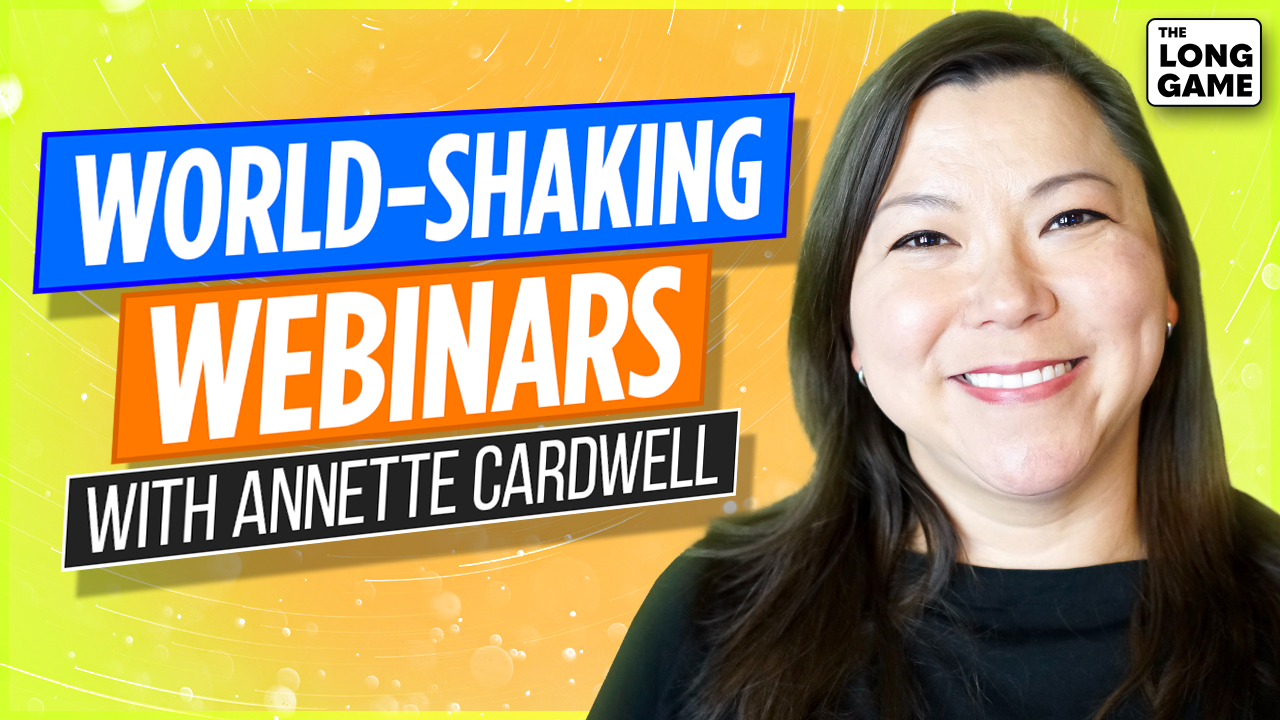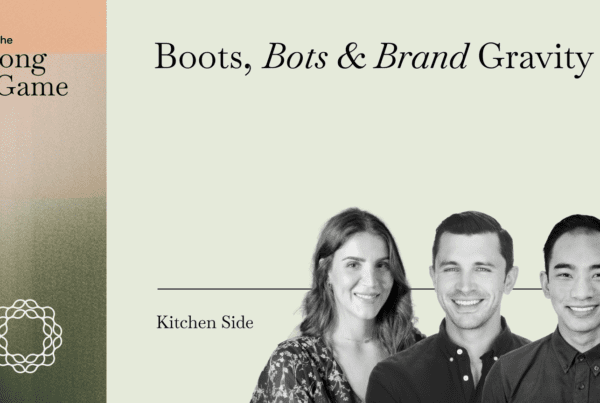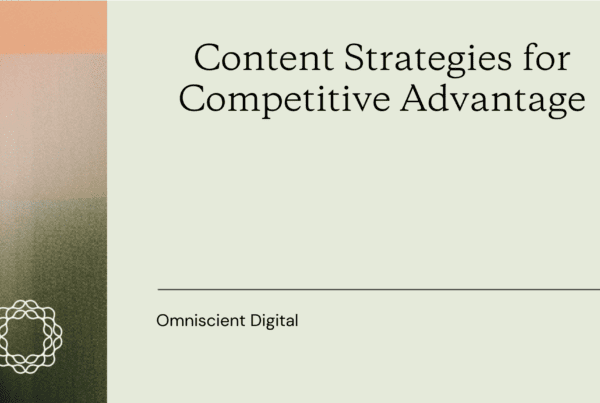
Want people to pay more attention to your brand? Give them interesting content to consume.
Webinars are the latest, greatest way to capture an audience’s attention.
Annette Cardwell is the Senior Director of Content, Community, Customer, and Web at Lattice. Events are a major part of Lattice’s company voice, and Annette has learned how to cater those events to her company’s specific audience.
In this episode, Annette shares her tips for creating the perfect event, how to select the right guests, and why you should always repurpose your content.
Show Topics
- Make topics interesting
- Cater events to your audience
- Select the right guests
- Don’t be salesy
- Determine which questions to cut
- Focus on your primary hook
- Work within your box
- Repurpose, repurpose, repurpose
- Be patient
- Provide value through content
Show Links
- Lattice’s All Hands Podcast
- Lattice’s Resources for Humans Virtual Conference
- Follow Annette Cardwell on LinkedIn or Twitter
Listen to the podcast
Watch a video clip
Key Takeaways
06:30 – Make topics interesting
How do you get more people to pay attention to your product? You do that by making your content interesting.
“When you’re a journalist, you really are all about, ‘How can I translate a topic?’ Whether it’s super interesting and you want to get across why it’s super interesting, or you want take something dry and complicated and make it more interesting for a mass audience. You want to get as many eyeballs on your content as possible on your journalism, on your writing. And I feel like that is a missing element to a lot of content teams in marketing is that even though your audience is more defined and more specific, especially the audience that’s likely to buy your product or whatever it happens to be, the more you can get into the top of the funnel is always great. That’s why we do SEO as a strategy. We are looking for as many interested parties as we can. And so media does that one thing very, very well. They don’t always run companies very well, bless their heart, but they do sometimes hit the mark on how do I get as many people to pay attention to my content? And I’m not talking about clickbait and these other things, it’s more just, how do I form a brand, first of all, for my content, and therefore for my company?”
15:10 – Cater events to your audience
Events are a huge part of your company’s voice and branding, so cater your events to your specific audience.
“It’s all about how do I program the best show that my audience is going to see as a must see, a must consume, a must share. So events is a huge part of your voice. It’s a huge part of your content strategy. It’s a tough one because not all teams are willing to share that value. I think a lot of marketing teams have events teams within and the events team tends to either outsource or do the content themselves, but having a content hand in the selection. Because you want your company to understand, ‘I understand this audience best. And so I know the topics that they’re talking about. I know the angles that will appeal to them the best.’ Are they more conservative? Are they more progressive? How do I frame the conversation so that it feels really palatable to that audience that’s going to consume? So, events was definitely our first step into the walk.”
18:28 – Select the right guests
Guest selection is an important part of planning a webinar or event. Your guests don’t have to be famous, they just have to bring an expert or unique point of view to the table.
“Good guest selection is the first step, and guest selection doesn’t have to be famous people. It can literally be just people who are super knowledgeable. One of our first virtual events we did in pandemic, we were really focused on what are the companies whose leaders we would want to hear from or who are actually doing innovative things that have great stories behind them? So it was more about curating great stories and voices. Some of it is I would go on and listen to them on a podcast and, ‘Oh, they have this great story, and they’re really fun.’ Or I’d go see a talk that they did in the before times, where I was like, ‘Wow, they’re super engaging. They have this great presentation that goes along.’ And so you have to do a bit of homework to find those voices and those stories for sure. And sometimes they’ll pitch them to you, especially if you develop a little bit of a name or you do a shout-out on your socials or whatever, apply to speak, and you can usually come across some really great gems that way. Then preparing the speakers, so if you have a moderator, making sure that person really knows how to do it right. Because a good host or moderator can make or break a conversation. And then really doing a bit of a prep call with those speakers, making sure they understand the flow, all those things lead to great experiences later, because then there’s no wasted time. There’s great conversation through and through.”
21:55 – Don’t be salesy
Your audience will smell a sales pitch a mile away. So in your events, focus on thought leadership instead of being salesy.
“Thought leadership is really the way to go and not making it too prescriptively. Any kind of sales pitch is pretty key. People will literally log out and not come back if they feel it’s too salesy. Anytime we have a little bit of a salesy anything in any of our content, we get comments back or NPS back from a survey that tells us that. So we try to avoid that, and the goal here is really to make Lattice look like an ally to this viewer. We get you. We understand your pain. So, it’s very high level and very thought leadership-y. I would also say, I want to go back to that moderator being a key point. Knowing how to get out of the way of answers. When you ask a question, let them answer it. I get wanting to create a conversational vibe on a podcast and having discussion, but 90% of it is knowing when to pull back and let them open up and talk. And especially some speakers take a while to get to the point exactly. But you have to know when to step in and help and when to just give it a little room, a little air to breathe, and get the really good shit out there.”
23:56 – Determine which questions to cut
You’ll always end up with less time than you thought you’d have. So, determine beforehand which questions are vital for the event and which ones you can cut if you run short on time.
“Webinars, I think, tend to be an hour long or maybe a little less. You want to get to a bunch of things. You want to cover a bunch of topics. But you also just have to prepare, or this is what I do anyway, prepare which questions I’m willing to give up and cut and which I really, really want the audience to come away with. Frontload it with those questions first. Know if I’m at a certain cutoff point to stop asking questions after a certain bit. And I also think it’s really key to also create some sort of interactivity in webinars where you can. So we do lots of polling. We collect questions ahead of time from the audience. We take questions always off of the Q & A as well at the end. It’s so hard to leave time for that, but having interactivity really makes people more invested and feel more engaged because they just feel like they’re being seen and heard and everybody loves that.”
26:01 – Focus on your primary hook
There should be one main takeaway or hook in your webinar that all your questions hang on. Focusing on one thing makes the message much cleaner and easier to understand.
“I’ve come up through all different kinds of media, but most of what I do is I’m an editor, I’m a curator. And curating the message I want, like when I’m editing an article or an e-book, it’s like, ‘This is the primary hook I want the reader to come away with.’ And I want everything within it to hang off of that hook. And it makes it much easier to say, ‘This doesn’t hang on that hook. I have to cut it.’ Because it really makes the message cleaner and makes you seem like a more focused, deliverer, content creator if you can do that, if you can winnow down. But there are obviously moments where you just want to let people talk and let it be free form. I think it’s just being wise about how often you do that in your content mix and how often you make it more focused and curated and edited down.”
45:07 – Work within your box
Every company has a box or framework of boundaries that they work within. The challenge is learning how to tell great stories within that box.
“As a journalist, as a former media person, I actually really love that challenge of finding the way to tell the story in that box that is limiting, because even at Brit + Co for example or at Fandom, we had a little bit of a box. It was certainly a bigger box, but there was a little bit of a box in how we wanted to frame stories, and not every guest is right for that framing. And so you may not want to bring on someone too edgy for an audience that sort of shys away from edginess, or maybe too mainstream and vanilla for a geeky audience that wants to get in the weeds. So, everybody has a box. Everybody has a framing that they have to work within. It’s your job as the content person, as a journalist, as an editor to make the story work for the frame and being really intelligent about that.”
01:08:24 – Repurpose, repurpose, repurpose
Content isn’t a once-and-done event. You can reuse and repurpose bits and pieces of that content for other things, such as articles and social media posts.
“The rule that both media companies and content marketers use all the time is repurpose, repurpose, repurpose. There’s never one bite of the apple for content. You should always think of ways that you can roll either some of the language that’s used or ideas or quotes or whatever into the next. So, if part of your walk is taking on social media programming for your company, which is a lot in some cases a part of the content team, you need to be thinking about social media extensions for all of your content, and if I make a video, how will I chunk this up and make it into social cuts for all my channels? How do I make animated assets out of this? How do I make data visualizations out of this and so on? And so the same goes for you wanting to turn podcast into books. You have a library of content to pull from. You see a lot of common themes, a lot of common threads, a lot of frameworks that work for many. How do you take the stories and use those as backing evidence, as proof points for your frameworks that you’re developing?”
01:14:32 – Be patient
It takes time to build brand value. You have to be persistent and patient as you build up your company’s reputation.
“It helps a hundred percent if your company is already bought in to content as a driver. I have that in spades. I’m so lucky, lucky, lucky that my leadership believes in the stuff we do. But that said, it took six to nine months to get a strong SEO showing. When you’re going from 0 to 10 or whatever your measure is, it takes time to build an audience in podcasts. It takes time for people, for good guests to come to you and want to be part of your events. I remember our first year doing the conference, everybody’s like, ‘What is this? I don’t know.’ And now we have literally dozens of people asking, ‘Hey, can I speak at your conference?’ So, it takes time, but it is worth it. And it builds tremendous brand value, which shows up in deals. You’ll actually hear people bring up, ‘Oh, I love your content,’ or, ‘I love your podcast,’ or whatever it is.”
01:21:31 – Provide value through content
A content creator’s goal is to offer valuable insight to people through content, and Annette loves seeing the payoff for that work.
“It’s really providing value for the people I am creating content for. There’s nothing more satisfying than when we see comments at our conference like, ‘Oh my God, I come every year because the content is so good.’ We have a Slack channel at Lattice where the sellers post about the deals that they close as they close them. It’s one of the most addictive channels on our Slack. And when a big deal comes in, they usually tag us in the message to say, ‘They came inbound, they did this. They were super interested. They love our content, blah, blah, blah.’ And that is so deeply satisfying. And that was the same thing in media. When a cover story was a hit or an article or a special package that we launched was loved by our audience, it was so rewarding. It was so rewarding just to get that feeling of, ‘Oh, they liked it.’ Like basic level.”
Join us for a 3-day deep dive series on how to drive business results with content.



